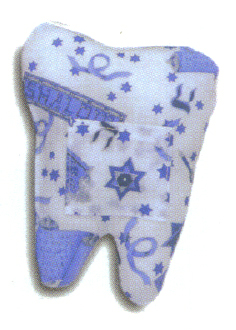
I am thrilled by this milestone, but feel that we should have a Torah way to mark it.
There is whole tooth fairy/truth debate, but I think it is secondary for the potential learning experience in tooth loss.
First, in retrospect, I should have promoted Cohava to say 'Shehechiyanu' when it fell out, to bring Hashem into the moment.
 When I searched online for what other people do for a Torah tooth loss, I was unimpressed with the results, although I enjoyed this article about teeth in the gemara and other rabbinic writings.
When I searched online for what other people do for a Torah tooth loss, I was unimpressed with the results, although I enjoyed this article about teeth in the gemara and other rabbinic writings.
I also looked at some Jewish themed tooth fairy pillows but prefer the fuzzy pink and white one Cohava and I sewed together.
 Still tooth and Torah-less, I started to think about what I have taught Cohava about teeth. A couple of weeks ago, for parashat Tazria Metzora, we made lashon toothbrush holders. In their parasha reader that week, it had explained that ones' teeth and lips are the soldiers and guardians against the tongue speaking lashon harah. Now Cohava is missing a solider she is going to need more reinforcements!
Still tooth and Torah-less, I started to think about what I have taught Cohava about teeth. A couple of weeks ago, for parashat Tazria Metzora, we made lashon toothbrush holders. In their parasha reader that week, it had explained that ones' teeth and lips are the soldiers and guardians against the tongue speaking lashon harah. Now Cohava is missing a solider she is going to need more reinforcements!
In addition to the money I will be giving her for the tooth (there is no reason to go against convention), Cohava will be getting a short note (not sure if it will be from me or the tooth fairy) about Lashon Hara. I need to reread the Chofetz Chaim (it will do me some good) so I can get the statements into phrases she will understand.
The first tooth is going to include a note which says: Fight the Lashon Hara! Do not say something that will hurt someone else."
If it is from the tooth fairy it might be written in pink on glittery paper.
If anyone has ideas on making tooth loss a teaching moment I would love to hear it!




















